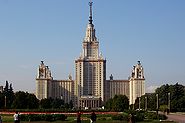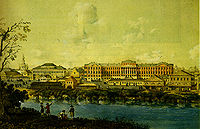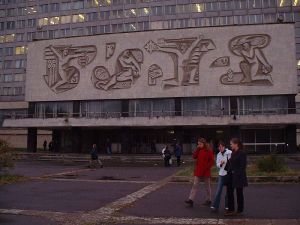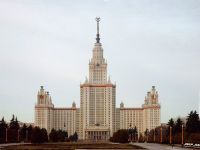Difference between revisions of "Moscow State University" - New World Encyclopedia
Nick Perez (talk | contribs) |
Nick Perez (talk | contribs) |
||
| Line 136: | Line 136: | ||
==Famous alumni and faculty== | ==Famous alumni and faculty== | ||
| − | + | *[[Alexei Alexeyevich Abrikosov|Alexey Abrikosov]] - Winner of 2003 Noble Prize winner in Physics | |
| − | *[[Alexei Alexeyevich Abrikosov|Alexey Abrikosov]] | + | *[[Pavel Alexandrov]] - famous mathematician |
| − | *[[Pavel Alexandrov]] | + | *[[Zalpa Bersanova]] - famous author and [[Cultural Anthropology|Ethnographer]] |
| − | + | *[[Anton Chekhov]] - famous author | |
| − | *[[Zalpa Bersanova]] | + | *[[Boris Chicherin]] - famous philosopher and Monarchist |
| − | + | *[[Yekaterina Romanovna Vorontsova-Dashkova|Ekaterina Dashkova]] - Princess in the Imperial Russian Court of the 18th century | |
| − | *[[Anton Chekhov]] | + | *[[Grigoriy A. Gamburtsev|Grigori Gamburtsev]] - Pioneer in Russian seismology studies |
| − | *[[Boris Chicherin]] | + | *[[Israel Gelfand]] - famous mathematician |
| − | *[[Yekaterina Romanovna Vorontsova-Dashkova|Ekaterina Dashkova]] | + | *[[Vitaly Ginzburg]] - 2003 Noble Prize winner in Physics |
| − | + | *[[Mikhail Gorbachev]] - last General Secretary of the Communist Party of the Soviet Union, winner of 1990 Noble Peace Prize | |
| − | + | *[[Alexander Herzen]] - major Russian pro-Western writer and thinker known as the "father of Russian socialism". | |
| − | *[[Grigoriy A. Gamburtsev|Grigori Gamburtsev]] | + | *[[Ion Iliescu]] - Former President of [[Romania]] |
| − | *[[Israel Gelfand]] | + | *[[Wassily Kandinsky]] - Early abstract artist |
| − | *[[Vitaly Ginzburg]] | + | *[[Pyotr Kapitsa]] - Winner of 1978 Noble Prize for Physics |
| − | *[[Mikhail Gorbachev]] | + | *[[Maxim Kontsevich]] - Winner of 1998 [[Fields Medal]] |
| − | *[[Alexander Herzen]] | + | *[[Igor Kurchatov]] - leader of the Soviet atomic bomb project |
| − | + | *[[Lev Landau]] - Winner of 1962 Noble Prize in Physics | |
| − | *[[Ion Iliescu]] | + | *[[Grigory Margulis]] - Winner of 1978 Fields Medal |
| − | + | *[[Nitiphoom Naowarat]] - Journalist and politician of [[Thailand]] | |
| − | *[[Wassily Kandinsky]] | + | *[[Aleksandr Oparin]] - Soviet biochemist and author of the theory of the origin of life |
| − | *[[Pyotr Kapitsa]] | + | *[[Andrei Sakharov]] - eminent Soviet nuclear physicist, dissident and human rights activist, winner of 1975 Noble Peace Prize |
| − | *[[ | + | *[[Yakov G. Sinai|Yakov Sinai]] - one of the most influential mathematicians of the twentieth century |
| − | + | *[[Sergey Stanishev]] - Prime Minister of [[Bulgaria]] | |
| − | + | *[[Igor Tamm]] - Nobel Laureate in Physics for the year 1958 | |
| − | *[[Igor Kurchatov]] | ||
| − | *[[Lev Landau]] | ||
| − | |||
| − | |||
| − | *[[Grigory Margulis]] | ||
| − | *[[Nitiphoom Naowarat]] | ||
| − | |||
| − | |||
| − | |||
| − | *[[Aleksandr Oparin]] | ||
| − | |||
| − | *[[Andrei Sakharov]] | ||
| − | *[[Yakov G. Sinai|Yakov Sinai]] | ||
| − | *[[Sergey Stanishev]] | ||
| − | |||
| − | *[[ | ||
| − | |||
==Footnotes== | ==Footnotes== | ||
Revision as of 02:57, 25 November 2007

| |
| Established | 25 January 1755 |
|---|---|
| Location | Moscow, Russia |
| Website | http://www.msu.ru/en/ |
M.V. Lomonosov Moscow State University (Russian: Московский государственный университет имени М.В.Ломоносова, often abbreviated МГУ, MSU, MGU) is the largest university in Russia. Founded in 1755, it is also the oldest.
Mission and Reputation
Moscow State University's 1998 charter established "democracy, openness and self-government to be the main principles in the life of Moscow University; the main goal is freedom to teach and to study as well as to develop oneself as a personality."[1] This reflects the long standing tradition of Moscow State as being the most prominent higher education institution in Russia. The university prides itself in its research facilities and projects, interdisciplinary programs in both the sciences and humanities as well as its high graduate and success rates. This reputation of excellence goes beyond Russia's boundaries; in 2007, the Moscow State University was ranked 76th, out of 500, of the best World Universities[2], and number 23rd in all of Europe[3]
History
The university was established on the instigation of Ivan Shuvalov and Mikhail Lomonosov by a decree of Russian Empress Elizabeth dated January 25, 1755, which is still celebrated as Students' Day in Russia.[4] First lessons were held on April 26.Originally located in the Principal Medicine Store on Red Square, the university was transferred by Catherine the Great to the present Neoclassical building on the other side of Mokhovaya Street. The main building was constructed between 1782 and 1793 to a Neo-Palladian design by Matvei Kazakov and rebuilt after Fire of Moscow (1812) by Domenico Giliardi. At this time the university had three faculties: philosophy, medicine, and law.
In 1804, medical education was split into Clinical (therapy), Surgical, and Obstetrics faculties. In 1884-1897, the Department of Medicine, supported by private donations, City Hall, and the national government, built an extensive, 1.6 kilometer long, state-of-the-art medical campus in Devichye Pole, between the Garden Ring and Novodevichy Convent.[5] In 1905, a social-democratic organization was created at the university calling for the tsar to be overthrown and for Russia to be turned into a republic. The Tsarist government repeatedly began closing the university. In 1911, in a protest over the introduction of troops onto the campus and mistreatment of certain professors, 130 scientists and professors resigned en masse, including prominent ones such as Nikolay Dimitrievich Zelinskiy, Pyotr Nikolaevich Lebedev, and Sergei Alekseevich Chaplygin. Thousands of students were also expelled. After the October Revolution in 1917, the school began allowing the admission of children of the proletariat and peasants, not just those of the more well-to-do petits bourgeois. In 1919, tuition fees were done away with, and a preparatory facility was created for children of the working class so that they would be able to pass the admission examinations.Cite error: Invalid <ref> tag; refs with no name must have content The political repressions of the 1930s and 1950s negatively affected the development of scientific ideas, as Soviet scientists had virtually no contacts with their colleagues abroad, while certain branches of science were condemned as based on the ideology alien to Communist ideas, and a number of scientists and scholars were sentenced for life imprisonment.
In 1940 the university was re-named in honor of its founder Mikhail Lomonosov, coinciding with the beginnings of WWII, another difficult time for the university. During the invasion of Russia by Nazi Germany, academic studies were suspended and most of the school was relocated far from the war front, yet hundreds of students and professors stayed to join the army and fought to protect the capital. Many researchers at the university stayed as well, carrying out programs to aid the war effort. After the war, lawyers from the university played a vital role in the Nuremberg and Tokyo trials.[6]
During the post-war period the leading role of Moscow University in the restoration and further development of the country was fully recognized. There was a fivefold increase in the state funding, the new University campus was built on Vorobievy Gory (Sparrow Hills), where all the lecture halls and laboratories had the latest equipment available at the time.
After 1991, nine new faculties were established. In 1992, a new charter was proposed and debated upon until 1998, when it was adopted. The result gave the university a unique status: it is funded directly from the state budget (bypassing the ministry of education) which provides a significant level of independence.[7]
Facilities
Since 1953, most of the faculties have been situated on Sparrow Hills, in the southwest of Moscow. The Main building was designed by architect Lev Vladimirovich Rudnev. In the post-war era, Stalin ordered seven huge tiered neoclassic towers built around the city. The MSU Main building is by far the largest of these. It was also the tallest building in the world outside of New York City at the time of its construction, and it remained the tallest building in Europe until 1988. The central tower is 240m tall, 36-stories high, and flanked by four huge wings of student and faculty accommodations. It is said to contain a total of 33 kilometers of corridors and 5,000 rooms. Facilities available inside the building include a concert hall, a theatre, a museum, various administration services, a library, a swimming pool, a police station, a post office, a laundry, a hairdresser's salon, a canteen, bank offices, shops, cafeterias, a bomb shelter, etc.
Along with the university administration, four of the main faculties - Faculty of Mechanics and Mathematics, the Faculty of Geology, the Faculty of Geography, and the Faculty of Fine and Performing Arts - now remain in the Main buiding. The star on the top of the tower is large enough to include a small room and a viewing platform; it weighs 12 tons. The building's facades are ornamented with giant clocks, barometers, and thermometers, statues, carved wheat sheaves, and Soviet crests (recently renovated). It stands before a terrace featuring statues of male and female students gazing optimistically and confidently into the future.
While the Sparrow Hills were on the outskirts of the city at the time of the construction of the Main building, they are now about halfway from the Kremlin to the city limits. Several other buildings and sports facilities were later added to the city campus, including the only baseball stadium in Russia. Currently, a new building is under construction for the social sciences faculties, and a vast new facility has just been built for the library, which is the second largest in Russia by volume (number of books). The university also has several dormitory buildings in the southwest of Moscow outside the campus.
The historical buiding on Mokhovaya Street now houses mainly the Faculty of Journalism, the Faculty of Psychology, and the The Institute of Asian and African Studies.
In addition to its many buildings, the MSU also houses several museums:
- Museum of Earth Science
- Anuchin Research Institute and Museum of Anthropology
- Museum of Zoology
- Museum of MSU History
Programs
In addition to offering undergraduate, graduate and post-graduate degrees in a majority of the humanities and sciences, as well as interdisciplinary, the university also grants medical and legal degrees.
Colleges
As of 2005, the university has 29 faculties:
- Faculty of Mechanics and Mathematics
- Faculty of Computational Mathematics and Cybernetics
- Faculty of Physics
- Faculty of Chemistry
- Faculty of Biology
- Faculty of Bioengineering and Bioinformatics
- Faculty of Soil Science
- Faculty of Geology
- Faculty of Geography
- Faculty of Materials Science
- Faculty of Fundamental Medicine
- Faculty of History
- Faculty of Philology
- Faculty of Philosophy
- Faculty of Economics
- Higher School of Business Administration
- Faculty of Law
- Faculty of Journalism
- Faculty of Psychology
- The Institute of Asian and African Studies
- Faculty of Sociology
- Faculty of Foreign Languages and Area Studies
- Faculty of Public Administration
- Faculty of Fine and Performing Arts
- Faculty of World Politics
- Faculty of Education
- Faculty of Further Education
- Moscow School of Economics
- Faculty of Military Training
- Department of Physical Education
The University hosts several research centers and institutes of study:
- Scobeltsyn Nuclear Physics Research Institute
- Research Institute of Mechanics
- Shternberg State Institute of Astronomy
- Belozersky Research Institute of Physico-Chemical Biology
- Computational Research Center
- Bogolubov Institute of Microworld
- Institute of Complex Systems Mathematical Research
- Anuchin Research Institute and Museum of Anthropology
- MSU- RAS Research Institute of Soil Science
- Institute for Information Security Issues
- Institute of World Cultures
- Russian-German Institute of Science and Culture
- MSU Media Centre
- MSU Emergency Centre
- Center for International Education
- Kolmogorov Research Centre
- Centre for Intensive Language Learning Programmes
- International Laser Centre
- Research Centre for Social Studies
- Cross-Disciplinary Research Centre for Magnetic Tomography and Spectroscopy
- Engineering Centre for Industrial Risk Assessment "Technorisk"
- International Research Centre for Biochemical Technology
- Centre for Social Science
- Lyapunov Franco-Russian Centre for Applied Mathematics and IT technology
- Research Centre for National Security
- Research Centre for Molecular Medicine
- Centre for Inservice Training for Specialists in Environmental Studies]
- Centre for Cultural Studies
- Information Centre
Student Life
Traditions
Famous alumni and faculty
- Alexey Abrikosov - Winner of 2003 Noble Prize winner in Physics
- Pavel Alexandrov - famous mathematician
- Zalpa Bersanova - famous author and Ethnographer
- Anton Chekhov - famous author
- Boris Chicherin - famous philosopher and Monarchist
- Ekaterina Dashkova - Princess in the Imperial Russian Court of the 18th century
- Grigori Gamburtsev - Pioneer in Russian seismology studies
- Israel Gelfand - famous mathematician
- Vitaly Ginzburg - 2003 Noble Prize winner in Physics
- Mikhail Gorbachev - last General Secretary of the Communist Party of the Soviet Union, winner of 1990 Noble Peace Prize
- Alexander Herzen - major Russian pro-Western writer and thinker known as the "father of Russian socialism".
- Ion Iliescu - Former President of Romania
- Wassily Kandinsky - Early abstract artist
- Pyotr Kapitsa - Winner of 1978 Noble Prize for Physics
- Maxim Kontsevich - Winner of 1998 Fields Medal
- Igor Kurchatov - leader of the Soviet atomic bomb project
- Lev Landau - Winner of 1962 Noble Prize in Physics
- Grigory Margulis - Winner of 1978 Fields Medal
- Nitiphoom Naowarat - Journalist and politician of Thailand
- Aleksandr Oparin - Soviet biochemist and author of the theory of the origin of life
- Andrei Sakharov - eminent Soviet nuclear physicist, dissident and human rights activist, winner of 1975 Noble Peace Prize
- Yakov Sinai - one of the most influential mathematicians of the twentieth century
- Sergey Stanishev - Prime Minister of Bulgaria
- Igor Tamm - Nobel Laureate in Physics for the year 1958
Footnotes
- ↑ (2007)Lomonosov Moscow State University ["MSU History"] Retrieved November 24, 2007
- ↑ (2007) Institute of Higher Education, Shanghai Jiao Tong University ["Top World Universities (1-99)"] Retrieved November 24, 2007
- ↑ (2007) Institute of Higher Education, Shanghai Jiao Tong University ["Top 100 European Universities"] Retrieved November 24, 2007
- ↑ Anisimov, E.V. Empress Elizabeth: Her reign and her Russia, 1741-1761, (Academic International Press 1995) ISBN 0875691404
- ↑ (2007) Lomonosov Moscow State University ["MSU History"] Retrieved November 24, 2007
- ↑ (2007) Lomonosov Moscow State University ["MSU History"] Retrieved November 24, 2007
- ↑ (2007) Lomonosov Moscow State University ["MSU History"] Retrieved November 24, 2007
External links
- Moscow State University
- Moscow State University campus on Google Maps
- (Russian) MechMath faculty - Unofficial website
- (Russian) CMC faculty - Unofficial website
- (Russian) Journalism faculty - Unofficial website
Credits
New World Encyclopedia writers and editors rewrote and completed the Wikipedia article in accordance with New World Encyclopedia standards. This article abides by terms of the Creative Commons CC-by-sa 3.0 License (CC-by-sa), which may be used and disseminated with proper attribution. Credit is due under the terms of this license that can reference both the New World Encyclopedia contributors and the selfless volunteer contributors of the Wikimedia Foundation. To cite this article click here for a list of acceptable citing formats.The history of earlier contributions by wikipedians is accessible to researchers here:
The history of this article since it was imported to New World Encyclopedia:
Note: Some restrictions may apply to use of individual images which are separately licensed.




